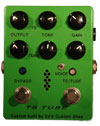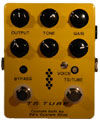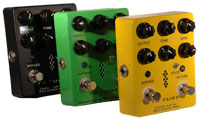Products by Ed’s Custom Shop
 Pico
Plexi Head
Pico
Plexi Head
The Pico Plexi Head is a miniature tube amp. It uses a 12AX7 in the preamp
and a 12AT7. The 12AT7 uses its triodes in push-pull in the power amp section.
This little amp is built completely point-to-point for its signal circuitry.
A modern switching DC-converter turns the 12V DC voltage that the Pico Plexi
Head gets fet through the supplied DC wall-wart (which operates throughout
the whole world!) into a whopping 280V for the plates under load at the power
amp section! Like the name of this amp already implies, its tonal magic stands
solid in the amp tones that are reminicent of the plexi marhall-erea. The
Volume and Tone controls are interactive with each other and take you from
a slightly crunchy guitartone right down to the classic marshall sound from
the sixties with all its dynamics, warm and smooth tone. Because the amp puts
out about 0,5 W. of output power, these beautiful tones are available at soundlevels
that are almost everywhere acceptable. It even comes with a built-in speaker!
Great if you’re into lofi sounds eg. for slide playing or intro-parts on your
recordings. The output section can get wired for either 4, 8 or 16 ohms. Simply
specify the cab you’re planning on using with this amp and I’ll wire the Pico
Plexi Head up accordingly!

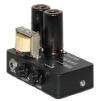






sound sample 1 - Hendrix
sound sample 2 - Clean Blues
sound sample 3
sound sample 4
Amp Pedal
 The
Amp Pedal is a very good example of a product that’s been developed through
frequent requests by customers that already got the Pico Plexi Head. They
already really, really liked the tone the Pico Plexi Head produces but wished
to be able to use that tone in bigger amp setups. Pretty much like a pedal
to be switched in and out of the signal chain.
The
Amp Pedal is a very good example of a product that’s been developed through
frequent requests by customers that already got the Pico Plexi Head. They
already really, really liked the tone the Pico Plexi Head produces but wished
to be able to use that tone in bigger amp setups. Pretty much like a pedal
to be switched in and out of the signal chain.
This is what the Amp Pedal does essentially. With the Amp Pedal, you can hook
up the Pico Plexi Head (but also amps like the Zvex Nano Head for instance)
into it via the upper two jacks and have the input and output fed by the guitar
into the amp respectively. A special speakercable is supplied with the unit
in order to be able to have the speaker output from the Pico Plexi Head connected
with the Amp Pedal. The connection from the Amp Pedal to the input of the
Pico Plexi Head is buffered through a special buffer circuit in order to make
it possible to use any length of cable between the Pico Plexi Head and the
Amp Pedal. This way, it’s possible to have the Pico Plexi Head set up safely
as part of the backline during gigs while having the Amp Pedal making part
of your pedalboard up front on the stage! The Amp Pedal also gets a lot of use in home-recording situations. The output
from the Amp Pedal gets connected through the soundcard on the computer and
having it set up this way, you’re able to record with the Pico Plexi Head
in complete silence! The Amp Pedal doesn’t
have a speaker simulated output (yet...) so you’d have to use a seperate speaker
simulator (either a circuit between the Amp Pedal and the input on your
soundcard (eg. the hughes and kettner redbox pro or palmer pdi-series) or
via the recording software in your computer) in this situation.
The Amp Pedal also gets a lot of use in home-recording situations. The output
from the Amp Pedal gets connected through the soundcard on the computer and
having it set up this way, you’re able to record with the Pico Plexi Head
in complete silence! The Amp Pedal doesn’t
have a speaker simulated output (yet...) so you’d have to use a seperate speaker
simulator (either a circuit between the Amp Pedal and the input on your
soundcard (eg. the hughes and kettner redbox pro or palmer pdi-series) or
via the recording software in your computer) in this situation.
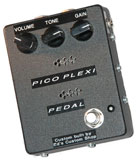 Pico
Plexi Pedal
Pico
Plexi Pedal
Essentially, the Pico Plexi Pedal is the Pico Plexi Head and Amp Pedal in
one enclosure. If you’re planning on using the Pico Plexi sound for live-use
only, this pedal is the most simple setup! Just plug your guitar into it’s
input, connect the output to your main amp and you’re ready to rock! It’s
still possible to use the Pico Plexi Pedal as an amp on it’s own too though.
There’s a little 3,5 mm. jack output on the left side of the pedal that operates
 as
a speaker-output. Just hook up your favourite speaker cab with this output
(using the supplied speaker cable) and you can use the pedal as an amp! The
output-control gets disconnected in this application.
as
a speaker-output. Just hook up your favourite speaker cab with this output
(using the supplied speaker cable) and you can use the pedal as an amp! The
output-control gets disconnected in this application.
sound sample 1
sound sample 2
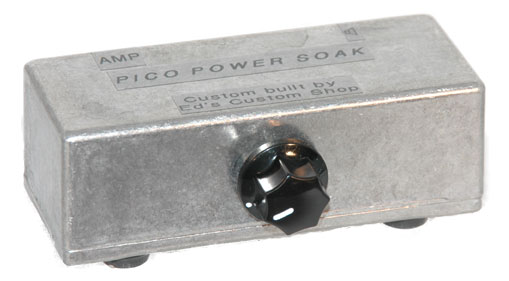 Pico
Power Soak
Pico
Power Soak
Allthough 0,5 watts of tube output seems like not much of a deal for an amp,
for some users this still is too loud. This also greatly depends on the efficiency
of the speaker used. So Ed’s Custom Shop has developed the Pico Power Soak!
Like its name implies, this is a power soak. You can vary the output of the
power stage of the Pico Plexi Head (or other low- output
amps like the Zvex Nano Head) to the speaker. This way, you can still crank
the amp up to the desired level while not having to deal with any sound pressure
at all.
output
amps like the Zvex Nano Head) to the speaker. This way, you can still crank
the amp up to the desired level while not having to deal with any sound pressure
at all.
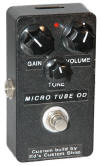 Micro
Tube OD
Micro
Tube OD
This was the first pedal I developed. My goal with this design was to be
able to have a pedal with a tube incorporated and still be able to have it
run on a single 9V battery. I just love tubes. Their response and abilities
in terms of dynamics are still unsurpassed by any other design and this clearly
shows in the Micro Tube OD. This pedals produces a great warm tube tone with
loads of dynamics. You can easily control the level of overdrive by varying
your pick attack and/or volume  level
on your guitar. The Micro Tube OD responds to all your playing nuances while
keeping its tone transparent and true. This pedal uses the DL 65/66/67 series
of tubes which are designed originally for hearing aids back in the early
sixties! It gets a great new life on its own again with the Micro Tube OD!
level
on your guitar. The Micro Tube OD responds to all your playing nuances while
keeping its tone transparent and true. This pedal uses the DL 65/66/67 series
of tubes which are designed originally for hearing aids back in the early
sixties! It gets a great new life on its own again with the Micro Tube OD!
sound sample
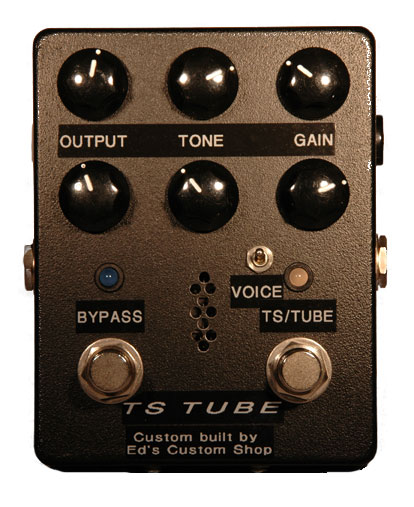 TS
Tube
TS
Tube
The TS Tube is a very allround pedal. Its design started as a joke to be
honest. I always wondered why a tubescreamer-based pedal was called a tubescreamer
because a: it doesn’t contain a tube and b: it doesn’t scream at all! So I
incorporated a tube circuit into a TS 9 Tubescreamer. This sounded great an
I have modded a couple of TS 9’s this way but eventually, making a seperate
pedal based on these modified TS 9 circuit seemed like a more practical way.
It also made it possible to expand the options of the design. The TS Tube
pedal has two sections: a TS-section and a Tube-section. Each section has
its very own character. The TS-section finds its home-base in the famous tubescreamer-anatomy
of course. Instead  of
a brutal copy of this circuit, I went a step further and improved this circuit;
I changed its tone in order to have more bass available, a much more wider
gain-range (both more and less) and different clipping characteristics via
the voice switch. From the classic mellow clipping to a more agressive one
or just more clean, like a preamp does. The voice-switch makes it possible.
of
a brutal copy of this circuit, I went a step further and improved this circuit;
I changed its tone in order to have more bass available, a much more wider
gain-range (both more and less) and different clipping characteristics via
the voice switch. From the classic mellow clipping to a more agressive one
or just more clean, like a preamp does. The voice-switch makes it possible.
Then there’s the Tube-Section. This section produces great tube tones that
go from crunchy to heavy saturated all with a very smooth response.
sound sample 2
sound sample 3
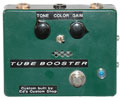
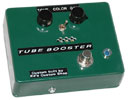 Tube
Booster
Tube
Booster
Sometimes you just want more of what you already got and like in your guitar
tone or you want to make sure your tone will remain clean and clear throughout
the whole signal path. The Tube Booster is a great tool in order to have this
done in a beautiful, warm and dynamic way. This pedal also runs on a tube
(a 12AX7) with high voltage on the plates. You can alter the output and the
tone with their respective controls and there’s a color-switch for even more
tonal options.
sound sample 1
sound sample 2
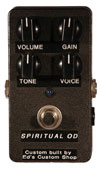
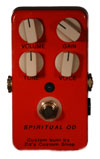 Spiritual
OD
Spiritual
OD
The Spiritual OD is inspired by the great guitar tones players like Robben
Ford and Larry Carlton get out of their Dumble amplifiers. Smooth overdrive
tones! The voice-control alters the gain- and tonal ranges available to the
overdrive circuit while the more usual gain-, tone- and volume controls determine
the amount of gain, highs and volume the pedal produces. The best way to set
up this pedal with your other equipment is by starting to adjust the voice-control.
After that, you can set the gain, tone and volume controls accordingly. Like
all pedals built by Ed’s Custom Shop, the Spiritual OD has true bypass switching,
led-indication and an input for dc.
sound sample 1
sound sample 2
